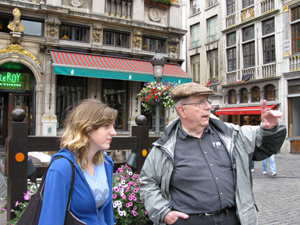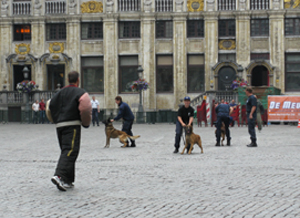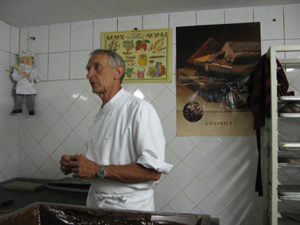Heading toward Brussels' Grand Place around midmorning we noticed unusual activity. Instead of roving groups of tourists,
 Learning Brussels geography
we found a half-dozen mounted police, several police on motorcycles, and yet more police on foot. We began to get
alarmed, and our anxiety increased when we saw that all four sides of the Grand Place were barred by yellow police ribbons.
What could be happening here?
Learning Brussels geography
we found a half-dozen mounted police, several police on motorcycles, and yet more police on foot. We began to get
alarmed, and our anxiety increased when we saw that all four sides of the Grand Place were barred by yellow police ribbons.
What could be happening here?
We were soon calmed by a young woman officer who told us that this was the annual Police Day. New graduates of the police
academy would be awarded their certificates, there would be lots of parades and demonstrations. Right now they were rehearsing
for the 3 p.m. ceremony.
So we joined others to watch some fancy motorcycle driving and -- most spectacular -- a demonstration of  Demonstration of police dogs
the Belgian shepherd
police dogs. A well-padded (and, we hope, highly paid) young man was the criminal, to be stopped and held by a dog at the
command of its trainer. We decided that the dog's bark, just before the attack, was the scariest part.
Demonstration of police dogs
the Belgian shepherd
police dogs. A well-padded (and, we hope, highly paid) young man was the criminal, to be stopped and held by a dog at the
command of its trainer. We decided that the dog's bark, just before the attack, was the scariest part.
The chocolate museum -- La Musee du Cacao et du Chocolate, which is very small, is an interesting place to visit, because the chocolatier demonstrates his technique
for making the mouth-watering Belgian candy. We followed behind a small group of students from a
culinary school who had plenty
of questions, thus giving us time to see several of the steps in the process. And there are free
 The unlucky criminal is subdued
samples!
The unlucky criminal is subdued
samples!
The critical part of making chocolates is keeping
the temperature of the batch precisely correct. It seems that much of the skill is learned -- the demonstrator's hands moved
so quickly they seemed to blur. He dipped his mold into the batch of chocolate before him, held it for a few moments, rapidly scraped the surface to provide smooth edges, carefully punched out air bubbles, and then inverted it with a flourish over the chocolate pot, letting the excess run out, leaving the shells which had just hardened to the mold enough. The tray was carefully placed on a metal cooling  Chocolate molds
plate where it would continue to cool before the chocolate could be filled from a pastry bag. Of course the untold secrets are just what proportions are used of chocolate and cocoa butter to obtain the melt-in-your-mouth character.
Chocolate molds
plate where it would continue to cool before the chocolate could be filled from a pastry bag. Of course the untold secrets are just what proportions are used of chocolate and cocoa butter to obtain the melt-in-your-mouth character.
Most other nations boast of chocolate makers, but to us the Belgians are without peer. The history of Belgium and its chocolates is
the disagreeable story of African colonialism, but that has changed with the centuries and now, although Belgian chocolate
still comes from Africa, its trade is regulated by contract, not by slavery.
For one final museum we stopped at the Museum of the History of Brussels, housed in one of the ornate  An artistic chocolatier
buildings on the Place
(which had re-opened after rehearsals had finished). The building itself was as interesting as the exhibits, which included
maps, photos and other artifacts. One popular exhibit is the collection of Mannekin Pis costumes. This small statue of a
toddler -- well -- pissing, is occasionally dressed in a uniform for a special holiday, or just for fun. The collection
includes national costumes from several countries and other regalia.
An artistic chocolatier
buildings on the Place
(which had re-opened after rehearsals had finished). The building itself was as interesting as the exhibits, which included
maps, photos and other artifacts. One popular exhibit is the collection of Mannekin Pis costumes. This small statue of a
toddler -- well -- pissing, is occasionally dressed in a uniform for a special holiday, or just for fun. The collection
includes national costumes from several countries and other regalia.
The next day we headed for Germany and a much different view of Europe. We were packed and ready, and thoroughly drilled to walk to the underground tram with our rolling suitcases just at the height of rush hour. Imagine our surprise when the tram was quite uncrowded at 7:45 in the morning. We had much time to spare waiting for the Thalys train which would take us to Cologne.
 Learning Brussels geography
we found a half-dozen mounted police, several police on motorcycles, and yet more police on foot. We began to get
alarmed, and our anxiety increased when we saw that all four sides of the Grand Place were barred by yellow police ribbons.
What could be happening here?
Learning Brussels geography
we found a half-dozen mounted police, several police on motorcycles, and yet more police on foot. We began to get
alarmed, and our anxiety increased when we saw that all four sides of the Grand Place were barred by yellow police ribbons.
What could be happening here?
 Demonstration of police dogs
Demonstration of police dogs The unlucky criminal is subdued
The unlucky criminal is subdued Chocolate molds
Chocolate molds An artistic chocolatier
An artistic chocolatier